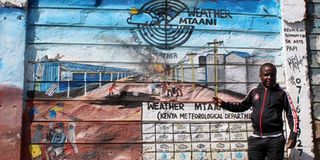Slum weather data project wins praises

Mr James Kirika shows a mural with different weather patterns in Laini Saba yesterday.
What you need to know:
- Garbage, poor drainage and appalling housing conditions are the order of the day in the slum.
- Daraja also uses artistes and community radio stations to create weather awareness.
For many Kenyans, the weather forecast is a routine that goes unheeded. But for residents of Kibera in Nairobi, being up to speed with weather patterns is a critical part of life.
Garbage, poor drainage and appalling housing conditions are the order of the day in the slum.
Rain comes with horror of telling proportions, sweeping down belongings, flooding homes with sludge and filth and destroying the shacks.
Mr James Kirika is a hero in Laini Saba village. Kirika, 29, is a ‘‘weather mtaani’’ leader, working for Daraja Climate Ambition – an initiative that gives weather reports to residents.
“We receive daily and weekly forecasts from the weather department and take the information to locals,” Mr Kirika, who works with 24 youth leaders, said.
Mr Mark Harvey, a co-founder of Daraja, said of the scheme: ‘‘We developed it to address lack of access of the urban poor to accurate, accessible and actionable weather, climate and early warning information.”
When the Nation team visited Mr Kirika, the sociology graduate was engrossed in his smartphone, reading the day’s weather charts and icons and translating and summarising them before dissemination to residents.
Weather awareness
“We convert the charts into text messages that are easily understood, including the use of Sheng,” he said
Daraja also uses artistes and community radio stations to create weather awareness. The initiative is so popular in Laini Saba, Soweto, Sokomoko and Makina villages that locals refer to Mr Kirika as the “weatherman”.
Murals bearing weather patterns dot these villages. A 2019 survey by Daraja showed that 98 per cent of residents act based on this information.
The outfit, Mr Harvey said, aims to improve resilience in slums by building bridges between communities and weather information providers”.
With climate change taking a toll on towns globally, slum inhabitants are at risk of displacement. Heatwaves have hit Nairobi twice in as many years.
Experts say the tin houses would not protect locals from being fried in the event of a full scale heatwave.
Ironically, while residents here suffered the devastation of erratic weather, they were left out of predictions by the Kenya Meteorological Department for decades.
“The language was too technical for them. Weather in Nairobi was generalised,” said Martin Ndereba, a Daraja champion.
Today, predictions are grouped into two. Zone One covers Kasarani, Ruaraka, Mathare and their neighbourhoods. Zone Two features Dagoretti, Lang’ata, Kibra and Starehe.
Drainage systems
Forecasts include what action to take. When rains are announced, community leaders mobilise residents to clear household and drainage systems. Those on river channels are told to move their belongings to safer ground.
“Locals are happy to be involved in weather issues,” Mr Kirika said.
Low-scale neighbourhoods in Nairobi are prone to fires, floods and other disasters due to crowding and unplanned construction. While disaster response by emergency services is usually swift, preparedness remains low.
Encroachment on the basin of River Ngong is so precarious that thousands are left homeless or lose property whenever it rains.
A seven-year-old girl was swept away while sleeping at her family’s Andolo village shack in September 2019. The body has never been found.
With naked lines dotting the landscape, accidents involving electricity are common.
“Kenya is a great test bed for innovation in Africa,” Mr Harvey said when asked why he chose the country for the project.
The story of Daraja will be premiered virtually during the January Global Climate Adaption Summit in the Netherlands.
The initiative won the International Collaborative Project of the Year Award at the 2020 British Expertise International Awards in October. It aims at cushion a billion people from climate disasters by 2025.
Mr Kirika and Mr Ndereba may be engaged full time or on voluntary basis in the project but nothing makes them happier than making a contribution to a safer community.





